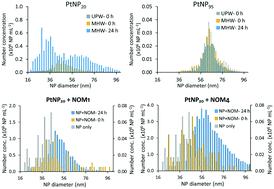当前位置:
X-MOL 学术
›
Environ. Sci.: Nano
›
论文详情
Our official English website, www.x-mol.net, welcomes your
feedback! (Note: you will need to create a separate account there.)
Nanoparticle size and natural organic matter composition determine aggregation behavior of polyvinylpyrrolidone coated platinum nanoparticles
Environmental Science: Nano ( IF 5.8 ) Pub Date : 2020-09-23 , DOI: 10.1039/d0en00659a Mithun Sikder 1, 2, 3, 4, 5 , Jingjing Wang 1, 2, 3, 4, 5 , Brett A. Poulin 5, 6, 7, 8, 9 , Malak M. Tfaily 5, 10, 11, 12, 13 , Mohammed Baalousha 1, 2, 3, 4, 5
Environmental Science: Nano ( IF 5.8 ) Pub Date : 2020-09-23 , DOI: 10.1039/d0en00659a Mithun Sikder 1, 2, 3, 4, 5 , Jingjing Wang 1, 2, 3, 4, 5 , Brett A. Poulin 5, 6, 7, 8, 9 , Malak M. Tfaily 5, 10, 11, 12, 13 , Mohammed Baalousha 1, 2, 3, 4, 5
Affiliation

|
Engineered nanoparticle (NP) size and natural organic matter (NOM) composition play important roles in determining NP environmental behaviors. The aim of this work was to investigate how NP size and NOM composition influence the colloidal stability of polyvinylpyrrolidone coated platinum engineered nanoparticles (PVP-PtNPs). We evaluated PVP-PtNP aggregation as a function of the NP size (20, 30, 50, 75, and 95 nm, denoted as PVP-PtNP20–95) in moderately hard water (MHW). Further, we quantified the effect of the hydrophobic organic acid (HPOA) fraction of NOM on the aggregation of PVP-PtNP20 and PVP-PtNP95 using 6 NOM samples from various surface waters, representing a range of NOM compositions and properties. NOM samples were characterized for bulk elemental composition (e.g., C, H, O, N, and S), specific ultraviolet absorbance at 254 nm (SUVA254), and molecular level composition (e.g., compound classes) using ultrahigh resolution mass spectrometry. Single particle-inductively coupled plasma-mass spectrometry (sp-ICP-MS) was employed to monitor the aggregation of PVP-PtNPs at 1 μg PVP-PtNP per L and 1 mg NOM per L concentrations. PVP-PtNP aggregate size increased with decreasing primary PVP-PtNP size, likely due to the lower zeta potential, the higher number concentration, and the higher specific surface area of smaller NPs compared to larger NPs at the same mass concentration. No aggregation was observed for PVP-PtNP95 in MHW in the presence and absence of the different NOM samples. PVP-PtNP20 formed aggregates in MHW in the presence and absence of the six NOM samples, and aggregate size increased in the presence of NOM likely due to interparticle bridging of NOM-coated PVP-PtNPs by divalent counterions. PVP-PtNP20 aggregate size increased with the increase in NOM elemental ratio of H to C and the relative abundance of lignin-like/carboxyl rich-alicyclic molecules (CRAM)-like compounds. However, the aggregate size of PVP-PtNP20 decreased with the increase in NOM molecular weight, NOM SUVA254, elemental ratio of O to C, and the relative abundance of condensed hydrocarbons and tannin-like compounds. Overall, the results of this study suggest that the composition and sources of NOM are key factors that contribute to the stability of PVP-PtNPs in the aquatic environment.
中文翻译:

纳米粒子的大小和天然有机物的成分决定了聚乙烯吡咯烷酮包覆的铂纳米粒子的聚集行为
工程纳米颗粒(NP)的大小和天然有机物(NOM)的组成在确定NP环境行为方面起着重要作用。这项工作的目的是调查NP大小和NOM组成如何影响聚乙烯吡咯烷酮涂层的铂工程纳米颗粒(PVP-PtNPs)的胶体稳定性。我们评估了PVP-PtNP聚合作为NP尺寸的函数(20,30,50,75,和95纳米,表示为PVP-PtNP 20-95)在适度硬水(MHW)。此外,我们量化了NOM的疏水性有机酸(HPOA)馏分对PVP-PtNP 20和PVP-PtNP 95聚集的影响使用来自不同地表水的6种NOM样品,代表了一系列NOM组成和特性。NOM样品的特征在于大块元素组成(例如C,H,O,N和S),254 nm处的特定紫外线吸收率(SUVA 254)和分子水平组成(例如,化合物类)使用超高分辨率质谱。单粒子电感耦合等离子体质谱(sp-ICP-MS)用于监测PVP-PtNP的聚集,浓度为每L 1μgPVP-PtNP和每L浓度1 mg NOM。PVP-PtNP聚集体的大小随初级PVP-PtNP大小的减小而增加,这可能是由于与相同质量浓度下的较大NP相比,较小的NP的Zeta电位较低,编号浓度较高且比表面积较高。在存在和不存在不同NOM样品的情况下,MHW中未观察到PVP-PtNP 95的聚集。PVP-PtNP 20在存在和不存在六个NOM样品的情况下,它们在MHW中形成聚集体,而在存在NOM的情况下,聚集体尺寸增加,这可能是由于二价抗衡离子在NOM包覆的PVP-PtNPs之间的颗粒间桥接。PVP-PtNP 20聚集体的大小随NOM元素H与C的比例增加以及木质素样/富羧基脂环族分子(CRAM)样化合物的相对丰度增加而增加。但是,随着NOM分子量NOM SUVA 254的增加,PVP-PtNP 20的聚集体尺寸减小,O与C的元素比以及缩合烃和单宁类化合物的相对丰度。总体而言,这项研究的结果表明,NOM的组成和来源是有助于PVP-PtNP在水生环境中稳定的关键因素。
更新日期:2020-11-03
中文翻译:

纳米粒子的大小和天然有机物的成分决定了聚乙烯吡咯烷酮包覆的铂纳米粒子的聚集行为
工程纳米颗粒(NP)的大小和天然有机物(NOM)的组成在确定NP环境行为方面起着重要作用。这项工作的目的是调查NP大小和NOM组成如何影响聚乙烯吡咯烷酮涂层的铂工程纳米颗粒(PVP-PtNPs)的胶体稳定性。我们评估了PVP-PtNP聚合作为NP尺寸的函数(20,30,50,75,和95纳米,表示为PVP-PtNP 20-95)在适度硬水(MHW)。此外,我们量化了NOM的疏水性有机酸(HPOA)馏分对PVP-PtNP 20和PVP-PtNP 95聚集的影响使用来自不同地表水的6种NOM样品,代表了一系列NOM组成和特性。NOM样品的特征在于大块元素组成(例如C,H,O,N和S),254 nm处的特定紫外线吸收率(SUVA 254)和分子水平组成(例如,化合物类)使用超高分辨率质谱。单粒子电感耦合等离子体质谱(sp-ICP-MS)用于监测PVP-PtNP的聚集,浓度为每L 1μgPVP-PtNP和每L浓度1 mg NOM。PVP-PtNP聚集体的大小随初级PVP-PtNP大小的减小而增加,这可能是由于与相同质量浓度下的较大NP相比,较小的NP的Zeta电位较低,编号浓度较高且比表面积较高。在存在和不存在不同NOM样品的情况下,MHW中未观察到PVP-PtNP 95的聚集。PVP-PtNP 20在存在和不存在六个NOM样品的情况下,它们在MHW中形成聚集体,而在存在NOM的情况下,聚集体尺寸增加,这可能是由于二价抗衡离子在NOM包覆的PVP-PtNPs之间的颗粒间桥接。PVP-PtNP 20聚集体的大小随NOM元素H与C的比例增加以及木质素样/富羧基脂环族分子(CRAM)样化合物的相对丰度增加而增加。但是,随着NOM分子量NOM SUVA 254的增加,PVP-PtNP 20的聚集体尺寸减小,O与C的元素比以及缩合烃和单宁类化合物的相对丰度。总体而言,这项研究的结果表明,NOM的组成和来源是有助于PVP-PtNP在水生环境中稳定的关键因素。











































 京公网安备 11010802027423号
京公网安备 11010802027423号